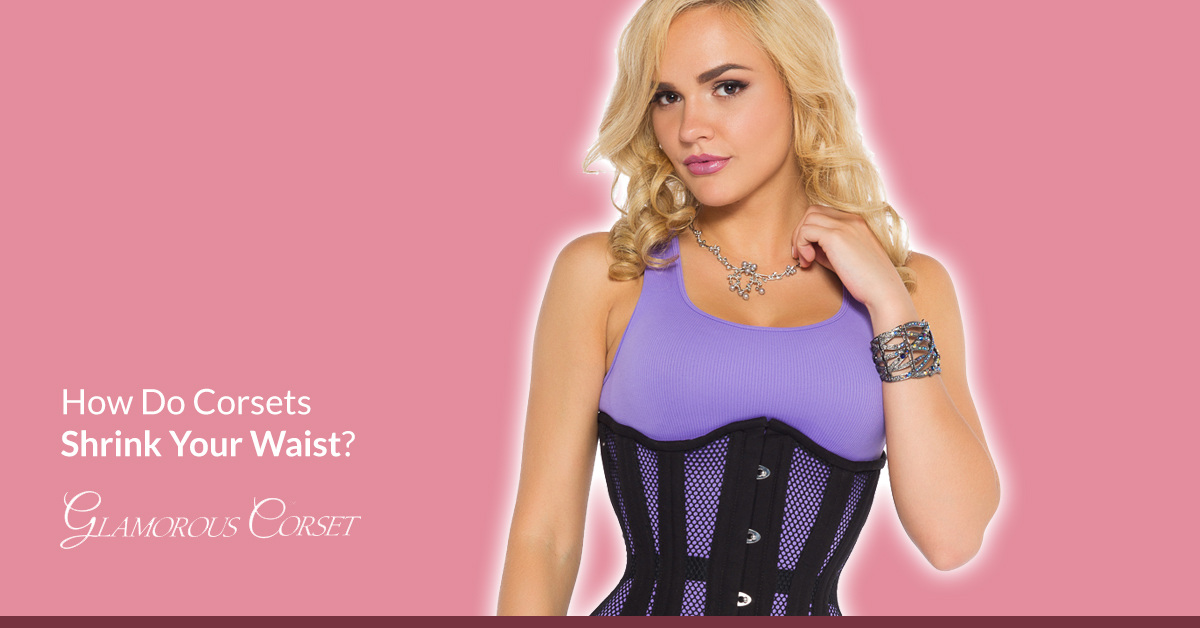Blog
How Do Corsets Shrink Your Waist?
Featured Corset: Jolie Black Mesh Corset
If you remember back to elementary science, you might recall that matter, or that which has mass and occupies space, cannot be destroyed. However, it can be changed or redistributed.
When it comes to extra matter around your midsection, it would be pretty great if you could simply transform it, like ice melting to become water or water dissipating into vapor. Unfortunately, our bodies don’t work this way.
The good news is that there are ways to redistribute your personal matter in order to create the shape you prefer, and corsets can be your greatest tool in this regard. When you don this compression garment, you gain the ability to contour your torso and slim your waistline.
How do corsets shrink your waist, and where does the extra matter go when you redistribute it? Here’s what you need to know to get the most from your waist training experience.
What’s in a Corset?
Waist training corsets may seem wondrous and magical, but there’s no trickery at play – it’s just good, old-fashioned engineering at work.
Like flying buttresses keep a cathedral from collapsing outward, and cables on a suspension bridge distribute compression forces that hold the span aloft, the tension created and maintained by a corset supports the hourglass figure you crave.
But how do corsets shrink your waist? It’s accomplished with the right materials, applied in a way that reshapes your soft tissue. It’s not rocket science, but there’s definitely science involved.
Steel Boning
The boning is what separates waist training corsets from wannabes. Fashion corsets try to look the part with telltale boning channels, but they’re often filled with cheap plastic that will bend and break under pressure. These corsets are merely for show.
Steel boning is incredibly robust, and when it’s distributed at intervals throughout the garment, it can withstand the tension of cinching to pull in your waistline. Some bones have a modicum of flex, but they will not bend – your body will give before they do.
Robust Textiles
Boning alone does not make a corset. The fabric that holds boning in place is equally important. It, too, needs to withstand the forces applied to it, and the thin materials found in fashion corsets simply aren’t up to the task.
Heavy-duty, tight-woven textiles like cotton coutil, canvas, denim, satin, mesh, and even leather offer the resilience needed to stand up to cinching without stretching, warping, tearing, or letting steel boning poke through.
The panels and boning channels come under incredible stress, and the right textiles are essential to the integrity of the garment.
How Do Corsets Shrink Your Waist Specifically?
Now that you have an idea of the mechanics of corsetry, you might be wondering how they apply to your body, specifically when it comes to shrinking your waistline. You need to consider a few key elements when choosing the right corset for your body and your waist slimming goals.
Proper Sizing and Spring
The place to start is with proper sizing, and it can be a little confusing if you’re new to the world of waist training. You will need more than the size of your waist to find the right corset.
You’ll have to take a few measurements, including your underbust, natural waist, hip, and torso length. If you want an overbust corset, an accurate bust measurement is also required.
With this information, you can find a corset that will fit like a glove. In some cases, sizes are based on your actual measurements, but some corset makers subtract a few inches for sizing (since you’re supposed to cinch the garment). If you encounter the latter, there will typically be a size chart included to help you out.
Don’t forget to look for spring or the ratio of waist circumference to the garment’s edge (usually the hip, but sometimes the underbust). This tells you how much the corset flares out from the waist. A curvier figure will benefit from greater spring.
The Shape of Things to Come
Now that you’ve found the right size, it’s time to consider shape in the “how do corsets shrink your waist” equation. There are several shapes to consider, starting with the popular hourglass that nips in at the waist and flares at the edges rather uniformly. Conical, pipe stem, S-bend, and Elizabethan corsets are also options.
The hourglass shape is ideal for beginners, but you’ll need to decide whether you want an overbust model to provide support for your breasts, an underbust model that allows you to wear a bra, or a waspie that covers just a few inches around the waist and makes for easy stealthing under clothes (or over, if you like a wide belt look).
Keep in mind the matter of matter redistribution we talked about earlier. When you squeeze in the waist, skin and fat will push out toward the edges, so if you’re trying to camouflage extra at the belly or back, it’s important to try different styles and find the model that suits your body best.
To stay up-to-date with weekly blog posts, waist training tips, and the chance to win one of our monthly corset giveaways, follow us on Facebook, Instagram, & subscribe to our mailing list and YouTube channel today! Want to find the perfect steel boned corset? Shop some of our favorites: underbust corsets, overbust corsets, corset dresses. You can also shop our corsets by material: cotton corsets, denim corsets, leather corsets, mesh corsets, pvc corsets, and satin corsets. Have questions about getting started with waist training or finding the right size corset? Contact us!

My name is Rachel, I am the owner of Glamorous Corset, a small business founded by me in 2010. Back In 2005, I was in a car accident that left me with a herniated disk. Much to my surprise I learned steel boned corsets were beneficial to several medical injuries including mine. I was always intrigued with corsetry, their history and their beautiful aesthetic. I love sharing knowledge about corsets, educating my wonderful readers and breaking the negative stigma related to corsetry. In combination with my years of research and personal experience I hope my articles are useful and can help anyone who has struggled with some of the same things I have. More about me…


